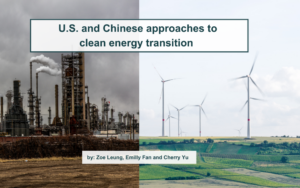December 7, 2022
by: Zoe Leung, Emilly Fan and Cherry Yu
Share this Article
What are the roles of the United States and China in accelerating the global clean energy transition? On one hand, the global energy landscape is undergoing fundamental changes, which will have far-reaching geopolitical consequences. On the other hand, the energy transformation remains an area where various forms of inclusive, supranational structures are crucial for providing global public goods. The U.S. and China’s ability to shape future energy systems hinge on their international strategies and efforts to persuade and work with partners and allies, to lead by example and to advance global norms and standards.
This report takes a narrow, diplomacy-focused perspective on the clean energy transition. It does not discuss whether or why to decarbonize or at which level is fair or adequate, nor does it seek to delve into U.S. and Chinese domestic and subnational efforts to meet each country’s climate pledges and challenges, although domestic actions are considered in the context of international diplomacy. Rather, it aims to highlight the two countries’ international clean energy policies and the intersection of foreign policy and the low- and zero-carbon economy, which previously have not been considered in a comprehensive manner. Additionally, the report briefly discusses recent U.S.-China energy engagement that informs future competition and cooperation between the two countries.
This report was written against the backdrop of intensifying U.S.-China strategic rivalry and heightened bilateral tensions over Taiwan, which triggered Beijing to suspend talks with Washington on climate. The diplomatic fallout from the growing rivalry makes it difficult for the two countries to collaborate on clean energy even when it is in their interest to do so. However, the climate emergency has become a social movement at the individual and business levels that necessitates stronger and more urgent collective actions, regardless of whether government leaders are on board with cooperation. Nevertheless, efforts by the world’s two largest economies and carbon emitters to support the global good play an outsized role in the global transition toward cleaner energy. It is our hope that mapping their international policies will provide insights into the trajectory of their priorities in the global fight against climate change, amid ever-changing geopolitical dynamics.


